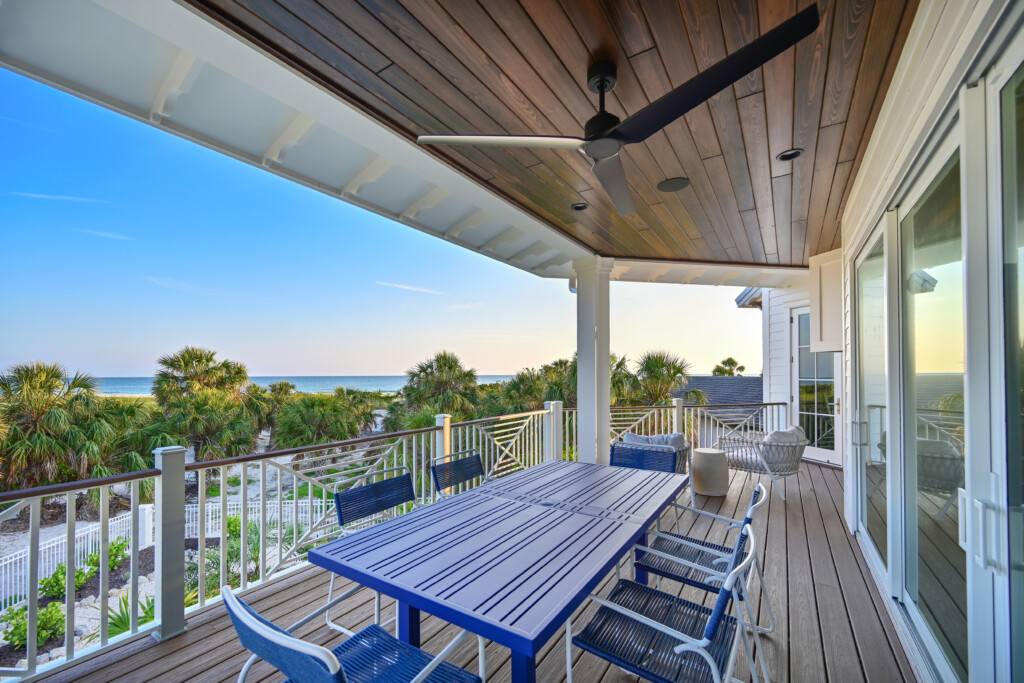Incorporating a rooftop patio into your custom home design is a great way to take full advantage of Florida’s year-round sunshine and scenic views. Whether you’re overlooking the Gulf or a lush canopy preserve, a rooftop space offers a private escape for entertaining, relaxing, or simply enjoying sunsets. However, designing a rooftop patio in Florida comes with unique challenges and considerations due to climate and structural demands. Here’s what homeowners should remember when working with their custom home builder for this spectacular feature.

6 Key Design Categories for your Rooftop Patio
-
- Structural Integrity and Engineering: Before anything else, ensure your custom home’s structure can support the additional weight of a rooftop patio. The load includes not only the deck materials but also furniture, planters, and people.Be sure you are working closely with a structural engineer from the early design phase. Consider concrete or steel framing if the patio will feature a hot tub, outdoor kitchen, or heavy furnishings. Make sure drainage and waterproofing systems are integrated into the overall roofing plan to prevent leaks into the home below.
- Weather and Sun Protection: Florida’s climate is both a blessing and a challenge. While the sunshine draws people outdoors, the intense UV rays, heat, and sudden downpours require thoughtful design. You may wish to consider utilizing pergolas, retractable awnings, or shade sails that will offer flexible sun coverage. UV-resistant furniture and decking will help to avoid fading and heat absorption. Misting systems or ceiling fans will help with temperature control during the hottest months.Because of the potential for severe weather such as hurricanes, wind-rated railings and anchoring systems are a priority. Built-in furniture won’t become dangerous in high winds, and secure lighting and décor with hurricane-rated fasteners will help to keep everything in place during storms.
- Materials Matter: Materials used on a rooftop must withstand high humidity, salt air (especially near the coast), and intense sun. Choosing the right ones will save on maintenance and replacement costs. Your best material choices may include composite decking or porcelain pavers which are weather-resistant and low-maintenance; and stainless steel/powder-coated aluminum for outdoor kitchens and railings. Be mindful of lighter-colored surfaces that reflect heat rather than absorb it, which can help with comfort and longevity.
- Privacy and Views: A well-designed rooftop balances openness with privacy. Homeowners can choose to install railings, landscaping, or built-in partitions to maintain seclusion without sacrificing the view. Smart strategies may include utilizing glass or cable railings that preserve sightlines while offering wind protection; or tall planters or green walls to create natural privacy screens. Be sure to orient seating areas away from neighboring houses or streets for a more secluded feel.
- Access and Safety: Safe, convenient access is a must. Whether via interior staircase, elevator, or exterior spiral stairs, the entrance should feel like a natural extension of the home.Some design notes to consider include:
- Interior access is ideal for integrating the rooftop into daily living.
- Ensure the entrance point is protected from water and wind intrusion.
- Install motion-sensor lighting and non-slip decking for safety at night or during rain.
- Lighting and Utility Access: A rooftop patio should be functional both day and night. Plan early for utility access to power, water, and possibly gas. You may wish to use low-voltage landscape lighting for ambiance and safety, or LED strip lighting under benches or along railings for a modern look. Expert Tip: Take advantage of the ample sunlight and install solar-powered fixtures for energy efficiency.When it comes to utilities, pre-wiring for outdoor speakers, a TV, or a mini-fridge will facilitate entertaining. If adding a grill or kitchenette, plan plumbing and gas lines during the home’s early construction phase.
Bruce Williams Homes Builds Unique Florida Residences
A rooftop patio can be the crown jewel of your custom home, offering panoramic views and unmatched outdoor living. When done right, a rooftop patio adds lasting value and daily enjoyment to your Florida lifestyle.
If you are interested in working with a professional builder with six decades of experience building custom homes on the Gulf Coast, call Bruce Williams Homes today.
Incorporating a rooftop patio into your custom home design is a great way to take full advantage of Florida’s year-round sunshine and scenic views. Whether you’re overlooking the Gulf or a lush canopy preserve, a rooftop space offers a private escape for entertaining, relaxing, or simply enjoying sunsets. However, designing a rooftop patio in Florida comes with unique challenges and considerations due to climate and structural demands. Here’s what homeowners should remember when working with their custom home builder for this spectacular feature.

6 Key Design Categories for your Rooftop Patio
-
- Structural Integrity and Engineering: Before anything else, ensure your custom home’s structure can support the additional weight of a rooftop patio. The load includes not only the deck materials but also furniture, planters, and people.Be sure you are working closely with a structural engineer from the early design phase. Consider concrete or steel framing if the patio will feature a hot tub, outdoor kitchen, or heavy furnishings. Make sure drainage and waterproofing systems are integrated into the overall roofing plan to prevent leaks into the home below.
- Weather and Sun Protection: Florida’s climate is both a blessing and a challenge. While the sunshine draws people outdoors, the intense UV rays, heat, and sudden downpours require thoughtful design. You may wish to consider utilizing pergolas, retractable awnings, or shade sails that will offer flexible sun coverage. UV-resistant furniture and decking will help to avoid fading and heat absorption. Misting systems or ceiling fans will help with temperature control during the hottest months.Because of the potential for severe weather such as hurricanes, wind-rated railings and anchoring systems are a priority. Built-in furniture won’t become dangerous in high winds, and secure lighting and décor with hurricane-rated fasteners will help to keep everything in place during storms.
- Materials Matter: Materials used on a rooftop must withstand high humidity, salt air (especially near the coast), and intense sun. Choosing the right ones will save on maintenance and replacement costs. Your best material choices may include composite decking or porcelain pavers which are weather-resistant and low-maintenance; and stainless steel/powder-coated aluminum for outdoor kitchens and railings. Be mindful of lighter-colored surfaces that reflect heat rather than absorb it, which can help with comfort and longevity.
- Privacy and Views: A well-designed rooftop balances openness with privacy. Homeowners can choose to install railings, landscaping, or built-in partitions to maintain seclusion without sacrificing the view. Smart strategies may include utilizing glass or cable railings that preserve sightlines while offering wind protection; or tall planters or green walls to create natural privacy screens. Be sure to orient seating areas away from neighboring houses or streets for a more secluded feel.
- Access and Safety: Safe, convenient access is a must. Whether via interior staircase, elevator, or exterior spiral stairs, the entrance should feel like a natural extension of the home.Some design notes to consider include:
- Interior access is ideal for integrating the rooftop into daily living.
- Ensure the entrance point is protected from water and wind intrusion.
- Install motion-sensor lighting and non-slip decking for safety at night or during rain.
- Lighting and Utility Access: A rooftop patio should be functional both day and night. Plan early for utility access to power, water, and possibly gas. You may wish to use low-voltage landscape lighting for ambiance and safety, or LED strip lighting under benches or along railings for a modern look. Expert Tip: Take advantage of the ample sunlight and install solar-powered fixtures for energy efficiency.When it comes to utilities, pre-wiring for outdoor speakers, a TV, or a mini-fridge will facilitate entertaining. If adding a grill or kitchenette, plan plumbing and gas lines during the home’s early construction phase.
Bruce Williams Homes Builds Unique Florida Residences
A rooftop patio can be the crown jewel of your custom home, offering panoramic views and unmatched outdoor living. When done right, a rooftop patio adds lasting value and daily enjoyment to your Florida lifestyle.
If you are interested in working with a professional builder with six decades of experience building custom homes on the Gulf Coast, call Bruce Williams Homes today.






